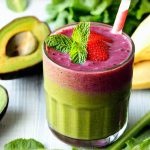Smoothies have become a cornerstone of modern nutrition, offering a convenient and delicious way to pack in essential vitamins and minerals. However, for individuals experiencing acid reflux, heartburn, or simply seeking a gentler approach to digestive wellness, the typical smoothie recipe can often be problematic. Many popular ingredients – citrus fruits, tomatoes, even large quantities of berries – contribute to acidity that exacerbates these conditions. The challenge lies not in eliminating smoothies altogether, but in thoughtfully crafting them with ingredients known for their soothing properties and lower acid profiles. This means shifting our focus from maximizing flavor intensity to prioritizing gentle nourishment and balanced nutrition.
The goal isn’t necessarily a “low-acid diet” per se (as that’s best determined by a healthcare professional), but rather a reduction of potential irritants within the smoothie itself. It’s about creating a beverage that supports, instead of challenges, digestive comfort. This often involves understanding how different foods interact in the body and selecting alternatives that offer similar nutritional benefits without triggering discomfort. We’ll explore strategies for building these gentle smoothies, focusing on ingredient choices, balancing flavors, and incorporating elements that actively promote gut health, all while maintaining a delightful taste experience. Understanding diagnostics that explore acid balance can also be helpful in identifying your triggers.
Building Blocks of Gentle Smoothies
The foundation of any good smoothie starts with understanding which ingredients are more likely to cause issues and how to mitigate them. Highly acidic fruits like oranges, grapefruits, lemons, limes, pineapples, and even large amounts of strawberries or raspberries should be used sparingly, if at all. Tomatoes, while technically a fruit, are also high in acidity and generally best avoided for those sensitive to acid. This doesn’t mean you have to completely eliminate these foods from your diet – just adjust their proportion within the smoothie or choose alternatives. The key is mindful substitution.
Instead of relying on citrus for vitamin C, consider options like amla (Indian gooseberry) powder, camu camu powder, or guava, which offer significant Vitamin C content with a lower acid load. For sweetness, dates are an excellent choice – they provide natural sugars and fiber, helping to balance the overall impact on blood sugar levels. Bananas, while slightly acidic, are often well-tolerated in moderation due to their creamy texture and potassium content. The real power lies in incorporating neutral or alkaline ingredients that can help buffer acidity.
Leafy greens, like spinach or kale (in smaller amounts if sensitive), provide incredible nutritional value without adding significant acid. Cucumber is incredibly hydrating and gentle on the stomach. Avocado adds a luxurious creaminess and healthy fats, contributing to satiety. And finally, plant-based milks – almond milk, oat milk, cashew milk, or even coconut water – offer hydration and can be chosen based on personal preference and tolerance levels. Remember that individual sensitivities vary, so pay attention to how your body reacts to different ingredients. Knowing flavor profiles that are gentle on the stomach can guide these choices.
Balancing Flavor & Nutrition
Creating a low-acid smoothie doesn’t mean sacrificing taste! In fact, it encourages creativity in finding new flavor combinations. The trick is to focus on enhancing the natural sweetness and depth of flavors from less acidic sources. Spices play an integral role here; cinnamon, ginger (in small amounts), nutmeg, and even a pinch of cardamom can add warmth and complexity without contributing to acidity. Vanilla extract – pure vanilla, not imitation – provides a comforting aroma and flavor boost.
A common mistake is trying to replicate the bright tang of citrus with other acidic ingredients. Instead, aim for balance by layering flavors. For example, pairing banana with avocado creates a creamy base, while adding a touch of cinnamon and almond butter adds depth and richness. Incorporating healthy fats – from avocados, nut butters, or seeds like chia or flax – not only improves the texture but also helps slow down sugar absorption, preventing spikes in blood sugar that can sometimes worsen digestive symptoms. Prioritize whole food ingredients over processed sweeteners or artificial flavors. Proper preparing and seasoning meals is key to avoiding irritation.
Beyond flavor, consider the nutritional profile of your smoothie. Don’t just focus on avoiding acid; ensure you’re getting a well-rounded blend of vitamins, minerals, and macronutrients. This means incorporating protein (plant-based options like pea protein, hemp seeds, or chia seeds are excellent choices), healthy fats, and complex carbohydrates from sources like oats or sweet potato (cooked and cooled). A truly gentle smoothie isn’t just easy on the stomach – it’s also a nourishing powerhouse that supports overall health.
Soothing Additions for Digestive Wellness
Beyond simply avoiding acidic ingredients, we can actively incorporate elements known to support digestive comfort. – Ginger is renowned for its anti-inflammatory properties and ability to soothe nausea. A small piece of fresh ginger (about ½ inch) or ¼ teaspoon of powdered ginger can make a significant difference.
– Chamomile tea, cooled, can be used as the liquid base for your smoothie, offering calming and digestive benefits.
– Probiotic-rich foods like kefir (dairy or non-dairy versions available) or a small amount of fermented coconut yogurt can help promote gut health and improve digestion.
However, even with these additions, moderation is key. Excessive amounts of ginger can be irritating for some individuals. Similarly, while probiotics are beneficial, introducing them too quickly or in large quantities can sometimes cause temporary digestive upset. Start slowly and observe how your body responds. Listen to your gut! It’s the best guide you have. Many find sweet treats gentle on their microbiome, too.
The Art of Ingredient Pairing
The way ingredients combine significantly impacts both flavor and digestibility. Some pairings naturally complement each other, creating a harmonious blend that’s easier on the stomach. For example:
– Banana + Avocado + Spinach + Almond Milk + Cinnamon = A creamy, subtly sweet, and nutrient-rich smoothie.
– Pear + Cucumber + Mint + Coconut Water + Chia Seeds = A refreshing and hydrating option perfect for warmer weather.
– Sweet Potato (cooked & cooled) + Mango + Oat Milk + Ginger + Vanilla Extract = A comforting and satisfying smoothie with a warm spice profile.
Avoid combining ingredients that are known to clash or create digestive discomfort. For instance, mixing large amounts of fruit with dairy products can sometimes lead to bloating or gas for some individuals. Experimenting with different combinations is the best way to discover what works best for you. Don’t be afraid to adjust recipes based on your personal preferences and sensitivities.
Building Your Gentle Smoothie – A Step-by-Step Guide
- Start with a liquid base: Choose from almond milk, oat milk, coconut water, or cooled chamomile tea. Approximately 1 cup is a good starting point.
- Add a creamy element: Avocado (¼ – ½), banana (½ – 1), or cooked sweet potato (½ cup) provide texture and healthy fats.
- Incorporate leafy greens: Spinach or kale (a handful) offer essential nutrients without significant acidity, but start small if you’re sensitive. Cucumber is a great alternative!
- Boost with protein & healthy fats: Add 1-2 tablespoons of nut butter, chia seeds, hemp seeds, or pea protein powder.
- Sweeten naturally: Use 1-2 dates, a touch of maple syrup (use sparingly), or a small amount of ripe pear.
- Enhance with flavor & digestive support: Add spices like cinnamon, ginger, nutmeg, or vanilla extract. Consider a probiotic-rich food like kefir or fermented coconut yogurt (small amount).
- Blend until smooth: Adjust the liquid as needed to achieve your desired consistency.
Finally, remember that these are guidelines, not rigid rules. The most important thing is to listen to your body and create smoothies that nourish you both physically and emotionally. Pay attention to how different ingredients affect your digestive system and adjust accordingly. With a little experimentation and mindful ingredient selection, you can enjoy delicious and gentle smoothies that support your overall wellness. Understanding first-line assessments can also help pinpoint sensitivities. And consider if seemingly healthy foods trigger stomach acid. Finally, try some slow-cooked meals for variety!


















